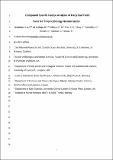Compound specific isotope analyses of harp seal teeth : tools for trophic ecology reconstruction
Abstract
As sentinels of ecosystem health, high trophic level predators integrate information through all levels of the food web. Their tissues can be used to investigate spatiotemporal variability in foraging behaviour, and with the appropriate analytical methods and tools, archived samples can be used to reconstruct past trophic interactions. Harp seal (Pagophilus groenlandicus) teeth collected in the 1990s from the Northwest Atlantic were analysed for bulk stable carbon and nitrogen isotopes (δ13Cbulk and δ15Nbulk), and compound specific stable nitrogen isotopes of amino acids (δ15NAA) for the first time. We developed a fine-scale, annual growth layer group (GLG) dentine sub-sampling method corresponding to their second and third year of life. In accordance with previous diet studies, while there was individual variability in δ15Nbulk, δ13Cbulk, and δ15NAA measurements, we did not detect significant differences in isotopic niche widths between males and females, or between GLGs. Relative trophic position was calculated as the baseline corrected δ15NAA values using trophic (glutamic acid) and source (phenylalanine and glycine) amino acids. Variability was measured between individuals in their relative trophic position, but within individual variability was low, suggesting that they fed at the same trophic level over these 2 years of life. These novel δ15NAA data may therefore suggest individual, specialist harp seal foraging behaviour in sub-adults. Our findings show that compound specific stable isotope signatures of archived, inert predator tissues can be used as tools for the retrospective reconstruction of trophic interactions on broad spatiotemporal scales.
Citation
Kershaw , J L , de la Vega , C , Jeffreys , R , Frie , A K , Haug , T , Mahaffey , C , Mettam , C , Stenson , G & Smout , S C 2021 , ' Compound specific isotope analyses of harp seal teeth : tools for trophic ecology reconstruction ' , Marine Ecology Progress Series , vol. 678 , pp. 211-225 . https://doi.org/10.3354/meps13867
Publication
Marine Ecology Progress Series
Status
Peer reviewed
ISSN
0171-8630Type
Journal article
Description
Funding: This work resulted from the ARISE project (NE/P006035/1 awarded to CM and RJ, and NE/P00623X/1 awarded to SS), part of the Changing Arctic Ocean programme, funded by the UKRI Natural Environment Research Council (NERC).Collections
Items in the St Andrews Research Repository are protected by copyright, with all rights reserved, unless otherwise indicated.

